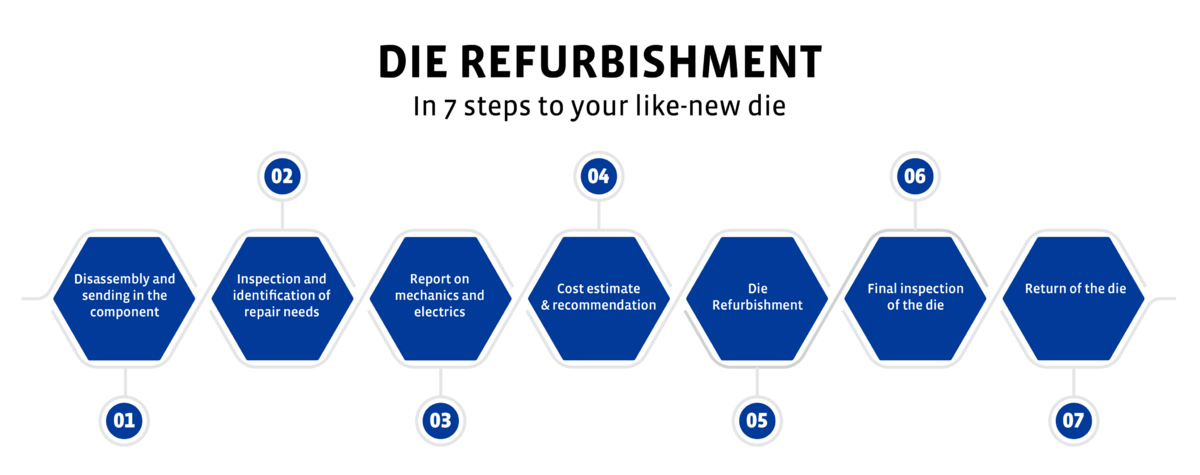
Die refurbishment: from old to new
At the latest when cleaning intervals become shorter or defects appear in the film, it is time to take a close look at the die - because it is a crucial component when it comes to productivity and quality. If the inspection reveals scratches in surfaces, damaged edges or worn parts, producers are faced with the decision to purchase a new die. However, this is a significant investment. "In many cases, a thorough refurbishment of the die is much less expensive, " says Thomas Kreft, die expert at Reifenhäuser. He advises customers who want to refurbish their flat die, special die or coextrusion adapters. After all, there are a number of things to consider when refurbishing dies.
Expertise for different die brands
Producers often use different dies, even from different manufacturers - which in turn differ from one another: This starts with different coatings, materials and geometries and ends with spare parts, which are not always easy to obtain, explains Kreft. "That's why we make a point of ensuring that our refurbishment team has a lot of experience with dies from very different manufacturers - and not just with our own components. After all, errors during refurbishment can, in the worst case, lead to a total defect of the die."
These dies are reworked by Reifenhäuser Service

State-of-the-art service equipment
The Reifenhäuser die refurbishment process starts with an initial inspection including measurement of the entire die geometry. "This ensures that the customer gets the die back one hundred percent with the same geometry that he sent us - but refurbished, of course," says Kreft. Coatings are also removed, and the die's need for repair is determined and coordinated with the customer.
Experience with dies from different manufacturers
The refurbishment team then updates the die mechanically, electrically and technically. To do this, among other things, all surfaces are ground, polished and restored to as-new condition. "Important for high quality here is the manual work, such as polishing the flow surface - there are many little things that matter. Our colleagues specialize in the subtleties of different manufacturers," Kreft explains.
High quality coatings
The reconditioned surfaces are then recoated: "This is the be-all and end-all: If the coating is not good, it comes off again, pores form and adhesion problems occur," says Kreft. Reifenhäuser therefore works with specially certified partners for coatings.
Optionally, the service team also repairs the die's electronics, for example, or adapts the die geometry to new material requirements. "We can change a lot on a die. But the decisive question is always: Is the refurbishment economical compared to a new purchase," says Kreft.
Quality: a like-new die
At the end of the die refurbishment process, a final inspection ensures that the refurbished die fulfills the same parameters as when it was first delivered and meets all the quality requirements of a new Reifenhäuser die. "After refurbishment, the die produces the same quality as a new die," says Kreft. "However, the costs are significantly lower."
Another advantage is that dies can be refurbished several times - how often and at what intervals depends on various factors. These include the quality of the coating, but also how the die is maintained. Regular, professional cleaning delays the necessary overhaul just as much as the interval between the last complete overhaul. "If customers wait too long, the overall service life decreases," explains Kreft, "because a lot more material then has to be removed during the refurbishment to get back to a good condition."
Checklist: Extending the service life of the die
With a well-maintained die, you produce quality longer. These include:
The raw material processed also influences the longevity of the die. "Many of our customers who process abrasive materials such as PVC send us their dies for refurbishment at fixed intervals and don't wait until quality degradation occurs," says Kreft.
Plan die refurbishment at an early stage
In general, producers should plan die refurbishment well in advance, as the work can take up to twelve weeks. "To ensure that the plant does not come to a standstill during this time, producers should have a die in stock that they can use during the refurbishment period," advises Kreft. "Especially with high throughputs, such an investment quickly pays for itself."
Would you like to learn more about die refurbishment? Then please feel free to contact us.

.png)